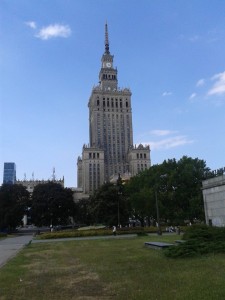 I am an enjoying a conference in Warsaw – the 17th International Conference on Crystal Growth and Epitaxy. We must be enjoying it, a lady from a neighbouring table asked 6 other attendees and me to keep the volume down – it seems we were talking and laughing too loudly – in a beer hall (Bierhalle). We probably weren’t behaving too badly, we’re all respectable people, including the Chair of one of the US’s best materials science departments (Cornell). The waitress was not at all sympathetic to the lady’s plight, so we were OK.
I am an enjoying a conference in Warsaw – the 17th International Conference on Crystal Growth and Epitaxy. We must be enjoying it, a lady from a neighbouring table asked 6 other attendees and me to keep the volume down – it seems we were talking and laughing too loudly – in a beer hall (Bierhalle). We probably weren’t behaving too badly, we’re all respectable people, including the Chair of one of the US’s best materials science departments (Cornell). The waitress was not at all sympathetic to the lady’s plight, so we were OK.
I took the picture above more-or-less in my first minute in Warsaw centre. It is the Palace of Culture and Science. What I think of as a typical communist-era statement building, i.e., huge and ugly. When you come out of a train station and see this size (237 m tall) of building, it is a pretty good clue you are in east europe.
The conference is also very big, over 1000 attendees. There are over 500 from the far east, mainly Japan. The meeting is quite broad but is mostly on growing crystals. For example, large single crystals of semiconductors are needed to make computer chips. Without our ability to grow near perfect crystals of silicon for example, there would be no computers, mobile phones, etc.
There have been some fun talks. How crystals form can be very complex. They come in all shapes and sizes, from simple cubes to beautiful snow flakes – which are ice crystals. And pure crystals are in high demand. People even resort to growing crystals in the weightless environment of space, aboard the International Space Station. On Earth as crystals grow in a liquid they tend to sediment to the bottom of the liquid, because crystals are usually denser than liquids so are heavier. This sedimenting to the bottom can interrupt the growth of a crystal on Earth. In space they float weightlessly in the liquid.

I quite like the Palace of Culture and Science. I can understand why the locals don’t, but it sure beats Norwich House